How to Build Culture at an Early-Stage Startup
How do founders shape culture at an early stage startup? In this post, I describe my learnings from nurturing company culture over the last four years as a founder.

When we started Kapwing back in 2018, my cofounder and I used to dream about how we would make our culture rich and unique once we had employees.
Gusto gives every new hire a watermelon. Notion has a shoeless office. Carta gives candidates a gorgeous offer letter. If we hired dozens of employees, what would be the symbols or traditions of our office space?
Maybe every person would go for a run with me (the CEO) on their first day. Maybe we'd include answering customer support tickets as part of onboarding. Maybe we'd come up with a cute nickname - Kaptains? - for the members of our team.
Now, 5 years later, we have a team of 40 based in San Francisco and New York. Although none of those cute ideas happened, our culture is pretty strong. Since those early conversations, I've learned a ton about company culture and how to build a culture that retains talent and enables innovation.
I've also noticed that questions about company culture are the most frequent from candidates applying for open jobs at Kapwing. When founders are recruiting, they must be prepared to give a snapshot of company culture. So, I'm writing this article to share my learnings with other first-time founders and pre-empt people interviewing at our company.
What is Kapwing's Culture Like?
This is the #1 question that we get from candidates applying for open jobs at Kapwing. So, we try to answer it prominently on our careers page and YouTube channel as it's relevant for people looking for a new role. Our company culture video to showcase the voices of our team:
To avoid redundancy, I won't describe our cultural pillars here. But yes, the career's page has an infographic that matches the posters hanging on the wall of our office, the slides in manager trainings, and the "Values" section of our getting started guide for new Kapwingers.
Interviewees who ask about culture are often asking about work-life balance and expected work hours. What I tell them is that Kapwing values creativity, and we know that wellness and psychological safety are key to creative thinking and risk taking. More specifically:
- Flexible hours: We have unlimited PTO and people control their own calendars and workflows. We have set "co-collaboration" hours and expect people to be available on Slack within these hours, but are flexible to communicated absences.
- In-person hybrid: Almost all Kapwingers work from the office on Tuesdays and Thursdays. Our offices are based in downtown San Francisco and Bushwick Brooklyn.
Learnings about Building Company Culture
The Controversial, Non-Obvious Aspects of Culture Are the Most Formative
Every company wants to be innovative, non-political, and fast-moving, but not every company is. The aspects of company culture that will most stick out, guiding your hiring strategy and the trajectory of your employees, are the ones that distinguish you from the average tech company.
For us, "Done is better than perfect" has always been a defining characteristic that separates us from the average startup. I find us using this mantra regularly to help our team avoid perfectionism and encourage risk taking.
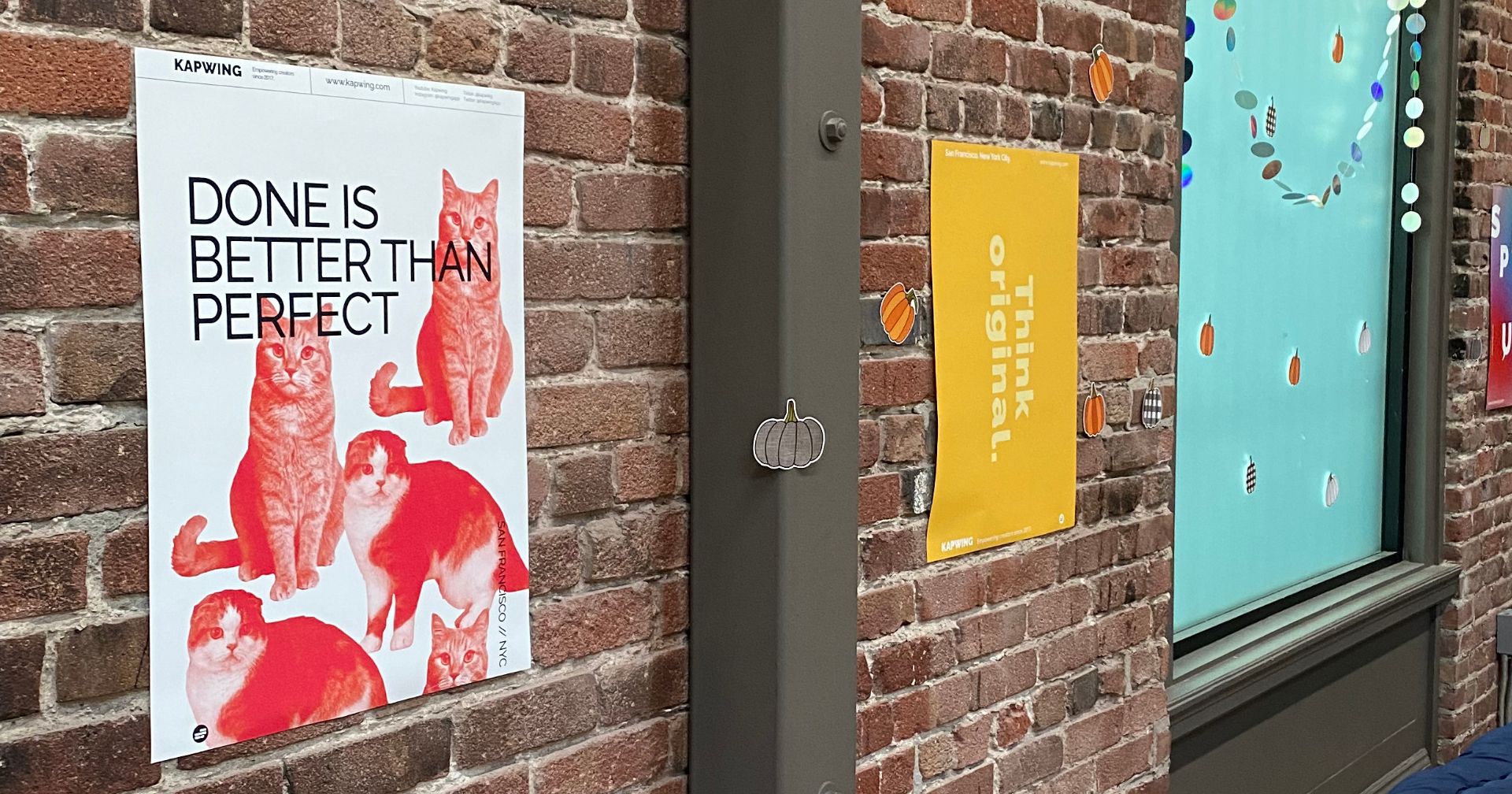
Show, Don't Tell
When talking to other people about your startup's culture, show, don't tell. Specific details are more memorable and credible than abstract generalizations. For example, at Kapwing, every engineer has production access. This is a better bit of info than "We give people autonomy to do their jobs." We've also updated our website more than once a day on average since we launched 4 years ago. This detail illustrates our velocity and tendency towards action.
We've found it's more effective to point candidates to artifacts of our culture than to try to describe it to them. Candidates often site our culture video as a reason they decided to apply. We also post startup culture videos on our growing Instagram, TikTok, and YouTube accounts.
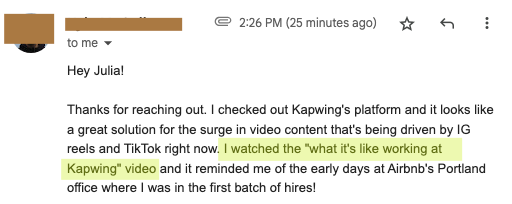
Consider How the Product and Business Impact Culture
Some aspects of the culture follow directly from the business model and industry. Consider what departments or functions are the most crucial for success at your startup, then optimize for that group.
I used to work at Google, a huge company where engineers lead the way and set culture. Stripe, in contrast, is a low-margin busienss and must squeeze out every penny. Companies like Adobe and Kapwing have more than 80% gross-margin, so our culture can afford to be more flexible and lax than, say, an airline.
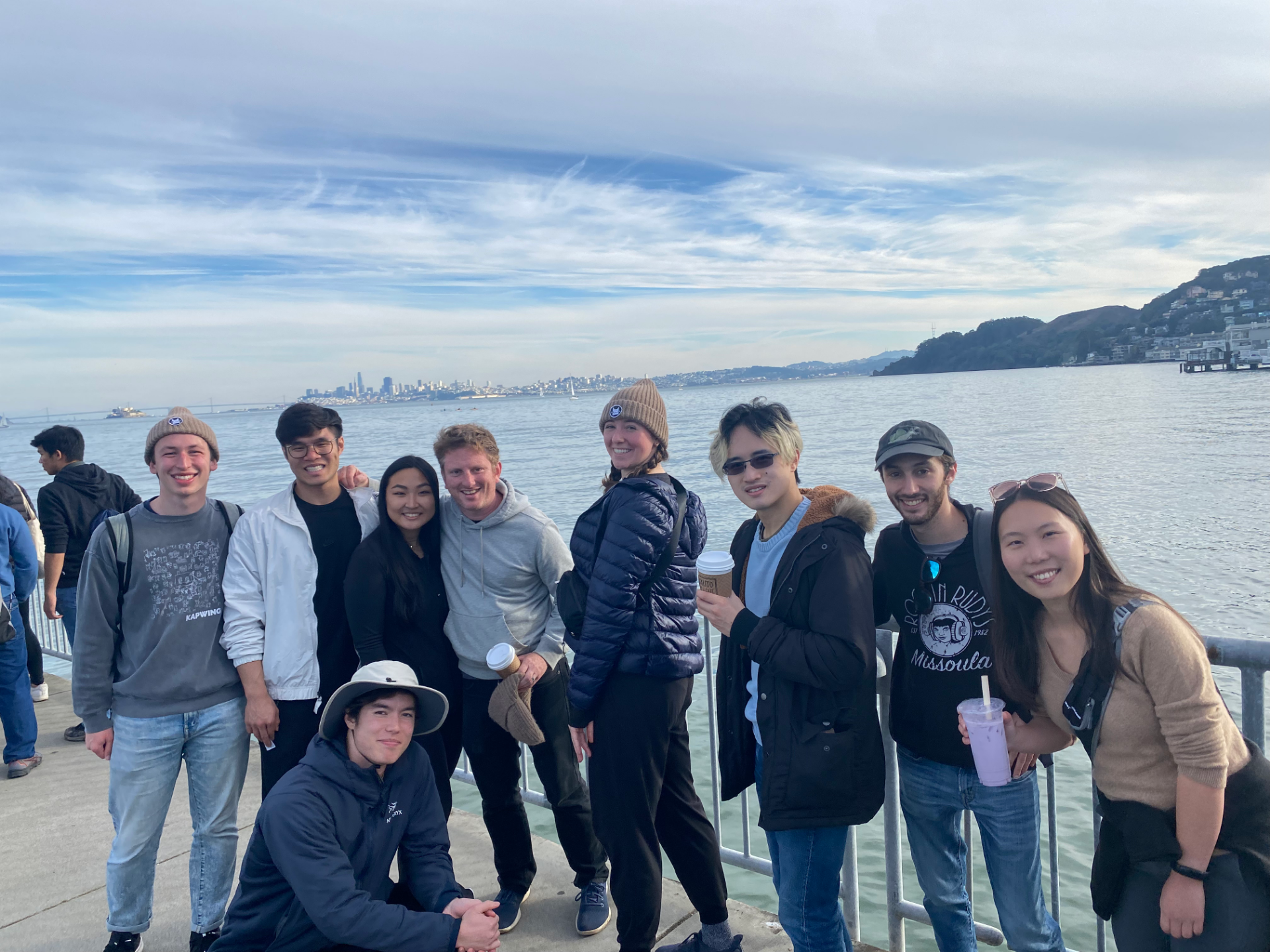
I've seen culture problems arise for some of my friends when, for example, a culture is designed in the early-days for engineers but later relies on sales people to drive revenue.
Find Some Way to Quantify
It's much easier to change what you can measure. To gauge the health of our company culture, we use a 4-question survey at the end of each quarter to get data from our full-time employees. Although it's limited, this survey gives us some signal to separate noise from patterns and troubleshoot culture issues.
I think of the EOQ survey as a leading indicator on the health of our business. Good culture leads to innovation, professional development, and retention down the road. The End of Quarter survey is the basis of our People Operations OKRs and has helped us build a sustainable business with steady growth. In my opinion, it's one of the things we've gotten right at Kapwing.
Our End of Quarter survey asks the same four questions:
- I feel that my manager and my team care about me as a person
- I feel challenged at work and I’m growing in my professional goals
- I trust Kapwing’s leadership
- If a friend was a good fit for an open role, I would strongly recommend Kapwing to them as a place to work
Kapwingers score each question on a scale of 1 (strongly disagree) to 5 (strongly agree) and can leave a free-response comment associated with any answer. We generally get very few comments (2-4 comments per question).

The EOQ Survey is completely anonymous and run through either Google Forms or Lattice in March, June, September, and December. We push to get 100% response rate from full-time employees only, meaning constant pings and a healthy dose of peer pressure until everyone's answers are in.
Culture (Mostly) Comes from the Founders
The biggest influence on culture is the behavior of the founders. People will copy what the founders do, not what they say. If founders are trying to solve a culture problem, the first place to start is with themselves: how do I embody this problem? How can I act to show what values I live by?
I’ve found this over and over again while working on Kapwing. For example, it bothered me that, before the pandemic, our team would often come in to work after 10:30am. I tried many things to change this culture problem: adding the expectation to onboarding guides. Scolding people who came into the office late. Mentioning it in performance reviews. Repeating the expectation at team all-hands. None of these really solved the issue, and almost every day a couple of people would arrive late.
One of the people who would occasionally come in late was my cofounder, Eric. Although he said that he understood the 10:30am work start, he still complained about it and said he was too lazy to get in by then. One week, I decided to change my approach from telling all Kapwingers they should come in before 10:30 to instead focusing just on Eric and getting his buy-in. After some convincing, he and I both pledged to come in at 10am everyday for two weeks. Sure enough, people stopped coming in late, and in the third week we had pushed up our work arrival time without saying a word. When we showed that we had the discipline to get to the office on time, we set a culture of arriving on time.
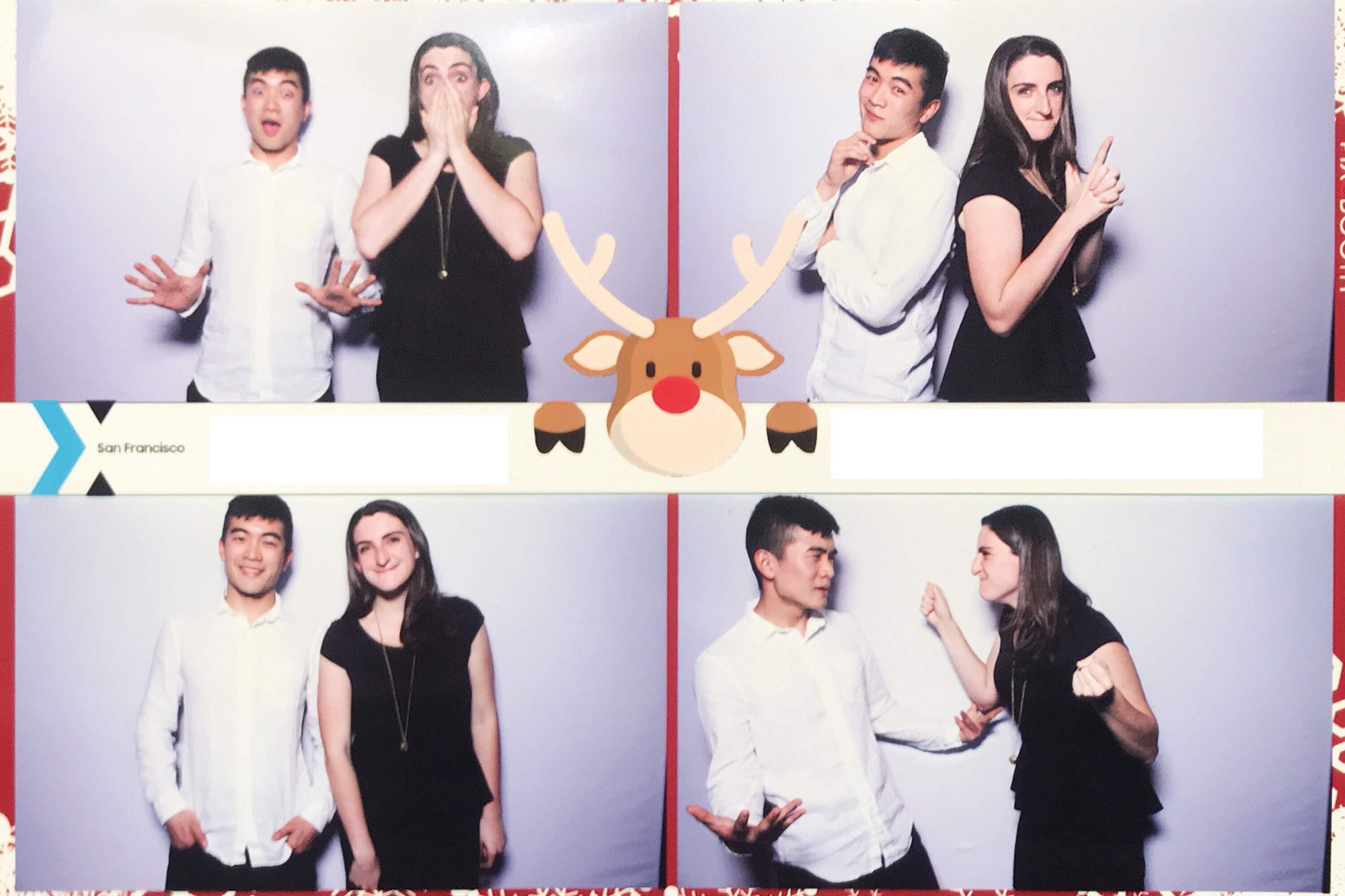
In our experience, the founders have even more impact than executives and managers. Even though Eric is no longer the CTO, he still has enormous influence on culture.
Frameworks Matter
Two years after starting Kapwing, I sat down with our team to thoughtfully discuss culture before a big hiring push. Everyone had ideas of what they wanted to see in our culture, but not everyone agreed on what to prioritize. At the same time, it's difficult to talk about company culture without a shared language or framework to reference.
I've found it much easier to intentionally build culture with the Radical Candor and Conscious Leadership frameworks to build off of. These materials are integrated into hiring, managment training, onboarding, and I highly recommend both books to founders, especially if you're a first-time manager. Santiago Suarez, the CEO of Addi, loved the Conscious Leadership framework so much that he would do a workshop for his team onsite each year costing north of $15,000. He saw this pricey experience as a worthwhile investment in culture.
Culture Evolves Over Time
Culture is about the guidance and processes you use to make decisions every day and the stories that you tell again and again. Like DNA, cultural memes stick when they create success and reproduce themselves in future batches of employees.
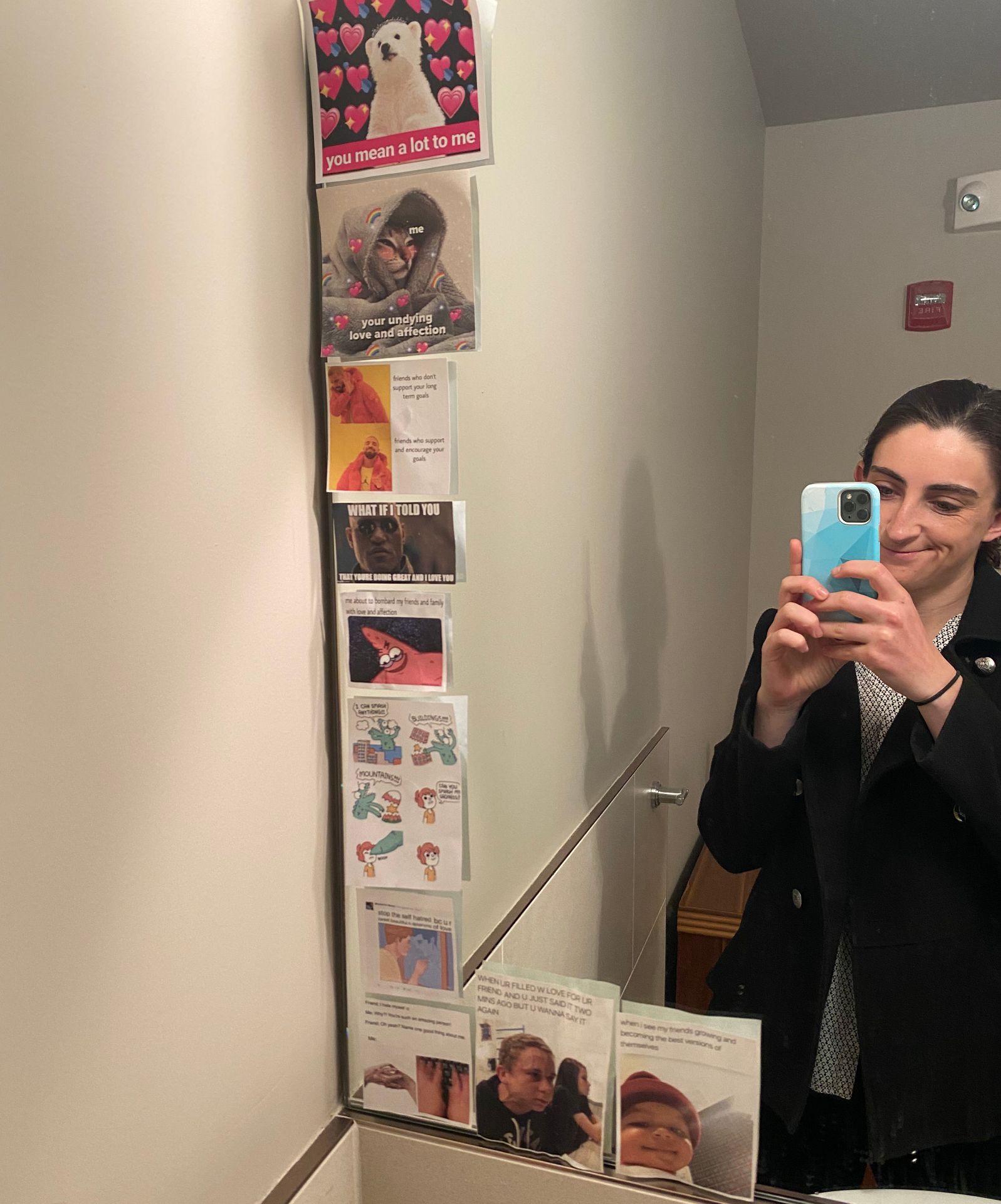
As a result, it's not possible to rigorously plan out your culture from day 1 – it will emerge organically from your habits and behaviors that lead to business success. To create great culture, be deliberate in selecting the most memorable stories that have a good moral, then telling and commemorating those stories for new hires. Like watermelons and doors for desks, good stories carry startup culture as the team grows.
Create content faster with Kapwing's online video editor →








